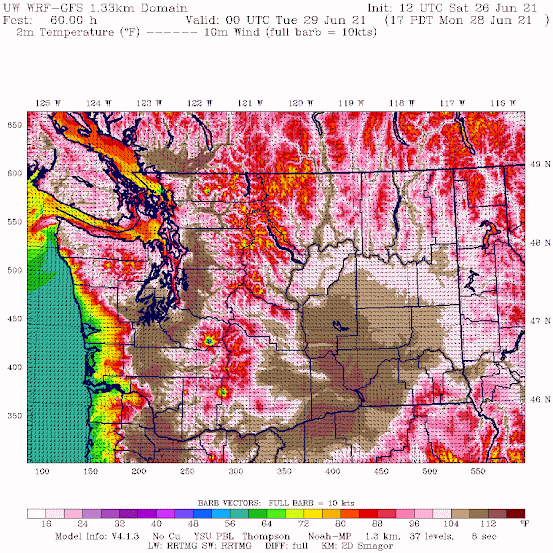Even before the heatwave, there was great concern about the potential for wildfires this summer. But now the worry is heightened and palpable.
My central point in this blog is that we could profoundly reduce the wildfire risk by taking some prudent steps immediately, but that will require state leaders to act with more energy and purpose than in the past.
Specifically, the state must: (1) immediately call for a ban on the use of personal fireworks, and (2) establish a comprehensive, coherent policy for de-energizing powerlines, guided by highly skillful weather forecasts.
The Lower Elevation of the Eastern Part of Our State is Ready to Burn
Due to the relatively dry spring and the warm temperatures of the past week, the eastern portion of the state is dry enough to burn. Now, a dry eastern Washington during summer is not unusual, but because of the dry/warm start, eastern Washington is several weeks advanced in fire potential.
So the conditions now are like those typically observed in mid-July. To illustrate, here is the latest 100-h dead fuel moisture (suitable for grasses and small diameter dead plants). Below 10% is dry enough to burn well. The potential for grass and range fires is real, and the threat is serious for the lower elevations of regional terrain as well.
Fireworks
Personal fireworks are a major cause of fires in our region. Several significant regional wildfires have been caused by irresponsibly used fireworks, such as the massive Eagle Creek Fire that spread to both sides of the Columbia Gorge. 50,000 acres were burnt over three months during September 2017, with serious air quality impacts for a major metropolitan area. Some of the most beautiful areas of the Columbia Gorge scenic area were destroyed, robbing a generation of visitors of the enjoyment of a stunning natural area.
Another wildfire was started by fireworks in Corbett, Oregon in September 2020 causing a roadside brush fire. Perhaps one of the most compelling pieces of evidence for the necessity of dealing with fireworks is the average number of new wildfires by date (see below). July 4th is the date the most fire starts. And the reason is not escaped barbecue fires.
And there are the numerous house fires and injuries caused by fireworks...but that is another story.
To deal with the real threat of fireworks-initiated fires, an immediate statewide ban on personal fireworks use if needed. Some counties and municipalities have already initiated bans and it is time for the governor to follow suit,
Stopping Power Line Fires
A number of the major wildfires last September were associated with strong winds causing powerline fires (either vegetation fell on the powerlines or the powerlines toppled onto trees). The power line initiated fires included the Malden Fire in eastern Washington and the Holiday Farm Fire in Oregon. I could name a dozen more.
Although vegetation management can greatly mitigate such fires and should be done, the only way to effectively eliminate the threat is to de-energize power lines in rural areas where a fire could be sparked by failing power infrastructure. Such powerline shutdowns have been used effectively in California.
A powerful tool for initiating such shutdowns is the ability to accurately forecast winds and dry weather. Using excellent forecasts, de-energizing lines can generally be done for a short period of strong winds.
At this stage, Washington State does not have a general or effective policy on shutting down powerlines and needs to develop one immediately.
Time To Act
Governor Inslee needs to deal with the wildfire threat immediately by establishing a fireworks ban and putting into place a de-energization plan that will be in place within weeks. Extensive parts of the state are dry enough to burn right now....all that is needed is the initiation of the fires and wind.
Today, a major (lightning-caused) fire has started in nearby British Columbia (the Lytton Fire) and has spread to over 12,000 acres, showing that the potential for large fires exists right now.
If state leaders do nothing and a major fire occurs during the next few months due to fireworks or powerline interactions with vegetation, responsibility will be clear. And vague statements blaming global warming will not be acceptable.
Finally, I should note that there are many long-term steps to reduce the wildfire threat that have been neglected, such as thinning the forests, bringing back more controlled fire, and modernizing the state's aged fire response capabilities (e.g., lack of modern aircraft), to name only a few. There is so much that can be done to lessen the potential for catastrophic fires in our state and we need leaders that will deal with the problem in a more coherent, energetic, and sustained way.























































